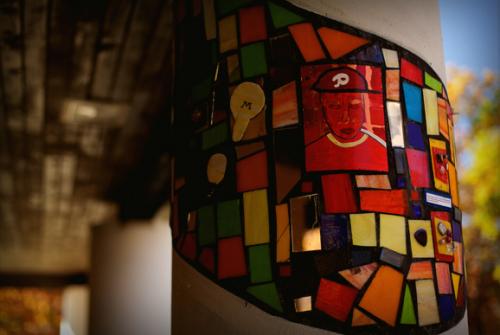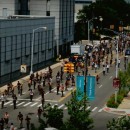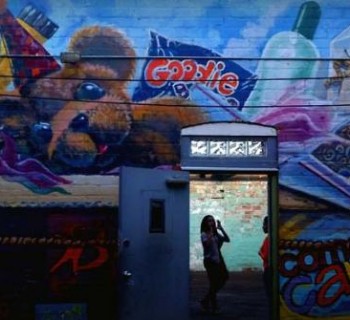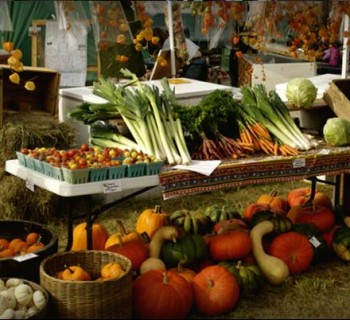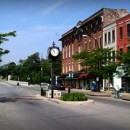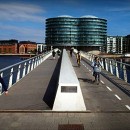Ann Arbor, Mich.—People feel strongly about public art.
Take the recent completion of German artist Herbert Dreiseitl's storm water installation in front of Ann Arbor's new municipal center. The tall sculpture collects rain water and filters it through a series of lighted drops and bends, eventually providing water for a colorful garden below.
Sounds pleasant enough, right? What's controversial about a giant water feature surrounded by pretty flowers? Well, if you read through the comments section of annarbor.com's story on the subject, you'd think Dreiseitl's design was closer to the Lenin statue in Seattle's Fremont neighborhood than it was to the humble, abstract water feature that it is.
Like we said, people feel strongly about public art.
This, however, isn't necessarily a bad thing, especially for someone like Connie Brown, one of nine commissioners and head of the Projects Committee for the Ann Arbor Public Arts Commission. The consternation expressed by critics of the municipal center water feature proves that citizens want to be a part of the public art dialog.
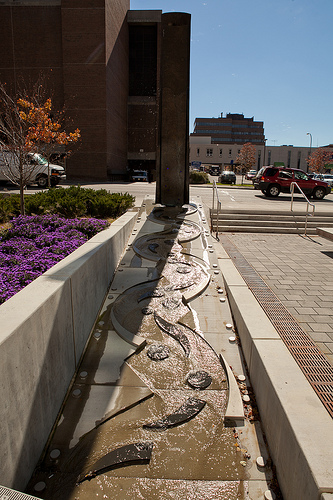 “We try to provide a lot of opportunities for different outcomes,” said Brown. The commission relishes the opportunity to engage and interact with the citizens of Ann Arbor. The goal is to result in “different pieces that speak to different people.”
“We try to provide a lot of opportunities for different outcomes,” said Brown. The commission relishes the opportunity to engage and interact with the citizens of Ann Arbor. The goal is to result in “different pieces that speak to different people.”
“People question money, the process, the aesthetic outcome,” said Brown. “We hope to have enough variety of pieces, variety of artists, to have something for everyone to like.”
The Ann Arbor Public Arts Commission was officially formed in 2007 to manage the city's Percent for Art ordinance. The ordinance, supported by Mayor John Hieftje and unanimously passed by City Council, guarantees that for every dollar spent on capital improvements paid by the city, one penny—or one percent of the total cost—must be designated for public art projects.
A stipulation to the ordinance is that the art resulting from a capital improvement project must somehow relate back to that project. For instance, the municipal center's water feature was funded through capital improvements to the city's various water and sewer utilities.
The commission hoped residents would approve a 0.10 mill in the recent election. If passed, the Art in Public Places Millage for 2013 – 2016 would have suspended the one percent ordinance, lifting the project-related restrictions placed on the AAPAC and all the while providing guaranteed money.
AAPAC itself is only a recommending body. They identify capital projects that are suited best for public art, projects with high exposure. AAPAC members then establish cost, then find and engage artists suitable to the job. The commission presents opportunities for public art to the city council, which then approves or denies an art project.
And that's not even the hard part. Marsha Chamberlin is chair of the commission. Besides cost, aesthetics, and community engagement, the potential for a project's success contains a number of “hidden elements.”
“The real challenge is determining the construction, durability, and public safety issues [of a project],” Chamberlin said.
AAPAC has successfully ushered through a number of public art projects to completion with several more on the horizon. Most recently, the shelter in Allmendinger Park received a colorful mosaic treatment from local artist Mary Thiefels. Included in the mosaic are self-portraits painted by students from nearby Slauson Middle School.
The shelter is an example of place-making, or what Connie Brown means when she says that AAPAC's goal is to create “an avenue for someone to come in and give something uninspired some beauty.”
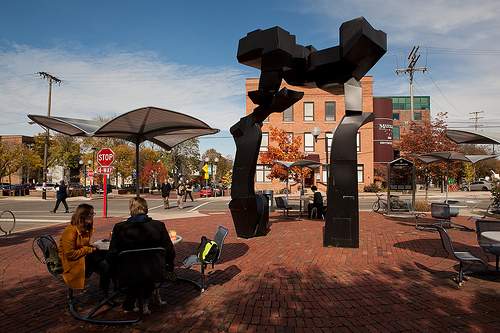 The commission has been holding a series of public meetings to engage residents in such place-making decisions. The first saw Brown give a brief presentation that high-lighted successful public art projects from all over the world and then segued into a more local focus. Brown then led an open discussion with residents, identifying areas ripe with potential for public art.
The commission has been holding a series of public meetings to engage residents in such place-making decisions. The first saw Brown give a brief presentation that high-lighted successful public art projects from all over the world and then segued into a more local focus. Brown then led an open discussion with residents, identifying areas ripe with potential for public art.
Apparent from the meeting is that people key in on art with an interactive bent. As one audience member put it, “No one's mentioning a bronze statue of the mayor.” What people were mentioning were the fun and interactive: fountains that shoot up from the pavement that kids can run through, sculptures that can be climbed on and posed with, and the famous Cloud Gate sculpture—or giant mirrored bean—in Chicago.
“If you're using tax payer dollars, it's important to respect the source,” said Chamberlin. “There may be more people who want to be involved. The more you engage people, the more they understand and you'll find more advocates than critics.”
As audience-members attempted to identify existing works of public art in the city, the idea of guided tours began to get tossed around. AAPAC commissioner Bob Miller was one step ahead of the crowd—literally.
Miller, an enthusiast of both art and fitness, has been plotting a public art running tour. Already a member of local running group PR Fitness, Miller designed a 6 mile run to weave through the Tree Forms in West Park to the Cube on the University of Michigan campus.
“My wife, daughters and I live blocks from downtown and we love to walk, bike and run through Ann Arbor. This is another reason I wanted to get involved with AAPAC, as I spend as much time out-side as I can enjoying my surroundings,” said Miller. “The primary reason we live so close to the city is so we can enjoy the city's pedestrian qualities, and I want to facilitate public art as being a part of my urban landscape, for myself and others to appreciate.”
Facilitating public art as part of the urban landscape is what the AAPAC is all about. Or as Connie Brown puts it, “Where art isn't something distant from you.”
Take Action: Do you have a favorite piece of public art? Take a photo of it on Instagram and tag it as #MSPubArt or tell us about it in the comments below.


